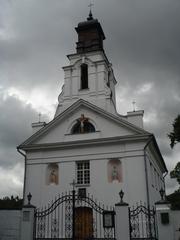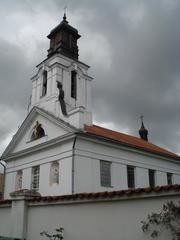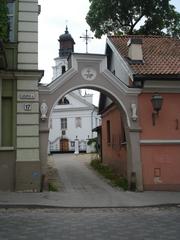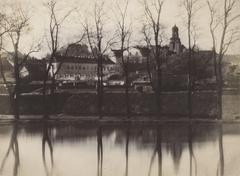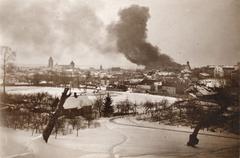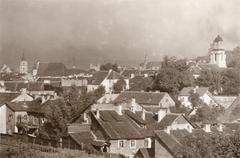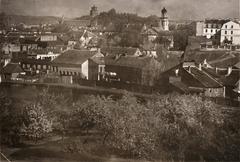
Church of St. Bartholomew Vilnius: Visiting Hours, Tickets, and Historical Guide
Date: 14/06/2025
Introduction
Set in the heart of Vilnius’s Užupis district—a vibrant enclave renowned for its creative energy and independent character—the Church of St. Bartholomew stands as a remarkable symbol of the city’s religious, cultural, and architectural legacy. Erected in 1824 and designed by Marcin Knackfus, this early Classicist church has witnessed the city’s transformations, from bustling guild fairs in the 17th century to periods of adversity and subsequent revival. Today, the church not only serves as a spiritual center for the Belarusian Catholic community, offering Mass in Polish and Belarusian, but also anchors the neighborhood’s annual St. Bartholomew’s Fair—an event recognized as Lithuanian national heritage that revives ancient crafts and traditions.
This comprehensive guide will walk you through the church’s compelling history, distinctive architecture, practical visitor information (including visiting hours and tickets), nearby attractions, and insider travel tips. Whether you’re passionate about Vilnius’s historical sites, Užupis’s artistic landscape, or Lithuania’s living traditions, this resource will ensure your visit is meaningful and memorable.
For further insights, consult Go Vilnius, We Love Lithuania, and Waymarking.com.
Table of Contents
- Historical Background
- Cultural and Architectural Significance
- Visiting Information
- Frequently Asked Questions (FAQ)
- Conclusion
- References and Further Reading
Historical Background
Origins and Early History
The Church of St. Bartholomew’s roots in Vilnius trace back to the 17th-century, when it was closely linked to the thriving potters’ guild and its annual fair. The earliest mention of St. Bartholomew’s Fair dates to 1664, establishing the church as a focal point of both religious life and communal celebrations (We Love Lithuania).
The current Classicist church, constructed in 1824, replaced earlier structures destroyed in regional conflicts. Unlike Vilnius’s grander Baroque and Gothic churches, St. Bartholomew’s modest design integrates harmoniously with Užupis’s residential fabric, perched atop a hill overlooking the Vilnia River (Go Vilnius).
Soviet Era and Restoration
During the Soviet occupation, the church was secularized and used as a sculptors’ workshop, a fate shared by many religious sites across Lithuania (Go Vilnius). Despite this interruption, the building’s structure survived, and following independence in 1990, the church was gradually restored.
Since 1997, St. Bartholomew’s has been home to Vilnius’s Belarusian Catholic community, with religious services conducted in both Polish and Belarusian. This revival underscores the resilience of Vilnius’s multicultural and spiritual traditions.
Cultural and Architectural Significance
Role in Užupis
Užupis, known for its bohemian spirit and self-proclaimed independence, finds in St. Bartholomew’s Church an important historical anchor. The church’s unassuming architecture and location reflect the neighborhood’s layered history, pre-dating its modern artistic identity (Go Vilnius).
St. Bartholomew’s Fair
The annual St. Bartholomew’s Fair is a living tradition dating back over 350 years. Now recognized as Lithuanian national heritage, the fair revives medieval and Renaissance crafts with demonstrations of pottery, weaving, blacksmithing, and more. It features processions, historical reenactments, lectures, and an interactive museum program, making it a vibrant celebration of Vilnius’s intangible heritage (We Love Lithuania).
Religious and Multicultural Importance
St. Bartholomew’s Church is unique in Vilnius for serving the Belarusian Catholic community, with Masses in both Polish and Belarusian. This reflects the city’s longstanding role as a crossroads of Eastern and Western Europe (Go Vilnius). The church continues to embody religious inclusivity and cultural resilience.
Architectural Features
The church is a fine example of early Classicist architecture in Vilnius. Notable features include:
- Single-nave plan—emphasizing simplicity and focus.
- Mono-pitched roof—sloping in one direction, suited to the climate.
- Two-storey bell turret—added in 1881, topped by a modest cupola (Waymarking.com).
- Plain façade—with a tympanum and large semi-circular window, flooding the nave with natural light.
The interior is serene and unadorned, in contrast to more elaborate Vilnius churches. Restoration efforts after the Soviet era have preserved its architectural integrity and historic character.
Visiting Information
Location and Access
- Address: Užupio g. 17, Vilnius, Lithuania
- District: Užupis—Vilnius’s artistic and independent neighborhood, easily accessible from the city center.
Getting There:
- On Foot: A 10–15 minute walk from Cathedral Square or the Old Town.
- Public Transport: Buses stop at Užupio and Šv. Mykolo gatvė. For schedules, see Vilnius Public Transport.
- By Bike: Bike rentals are available; the area is pedestrian-friendly.
Visiting Hours and Tickets
- Hours: Daily, 10:00 AM–6:00 PM. Hours may vary during services and special events; check ahead for the latest information.
- Admission: Free; donations for restoration are appreciated.
Guided Tours
Guided tours focusing on the church’s history and architecture can be booked through local operators or as part of Vilnius church walking tours. Inquire at the Vilnius tourist information center or via the Audiala app.
Photography and Events
- Photography: Allowed outside of services; always respect worshippers and signage.
- Events: The annual St. Bartholomew’s Fair (late August) is the major event, featuring craft demonstrations and historical reenactments. Occasional concerts and exhibitions are also hosted—check local listings.
Accessibility
- Wheelchair Access: Main entrance is accessible; contact the parish in advance for additional assistance.
- Facilities: Public restrooms are available in nearby cafés.
Nearby Attractions
- Užupis Art Incubator: Contemporary art gallery and workshops.
- Bernardine Cemetery: Historic park-like cemetery.
- St. Anne’s Church: Famed Gothic masterpiece.
- Vilnius Old Town: UNESCO World Heritage streets, shops, and cafés.
- Gediminas Tower: City views and history.
Frequently Asked Questions (FAQ)
Q: What are the church’s visiting hours?
A: Typically 10:00–18:00 daily; check ahead for updated times.
Q: Is there an entrance fee?
A: No, admission is free; donations are welcome.
Q: Are guided tours available?
A: Yes, by appointment through local tour operators or as part of walking tours.
Q: Is the church wheelchair accessible?
A: Yes, with accessible entry; assistance can be arranged.
Q: In which languages are services held?
A: Polish and Belarusian.
Q: Can I take photos inside?
A: Yes, except during services or if otherwise indicated.
Q: What is the St. Bartholomew’s Fair?
A: An annual two-day event in late August, celebrating medieval and Renaissance crafts. (We Love Lithuania)
Conclusion
The Church of St. Bartholomew is a living testament to Vilnius’s spiritual, cultural, and architectural diversity. Its understated elegance, vibrant traditions, and welcoming community offer visitors a deeply authentic experience at the intersection of history and modern creativity. Situated within the artistic heart of Užupis and surrounded by some of Vilnius’s most cherished sites, the church is an essential stop for anyone seeking to understand the city’s heritage.
Make the most of your visit by checking opening hours, joining a guided tour, and exploring the surrounding Užupis district. For a richer experience, download the Audiala app for self-guided audio tours and up-to-date visitor information.
